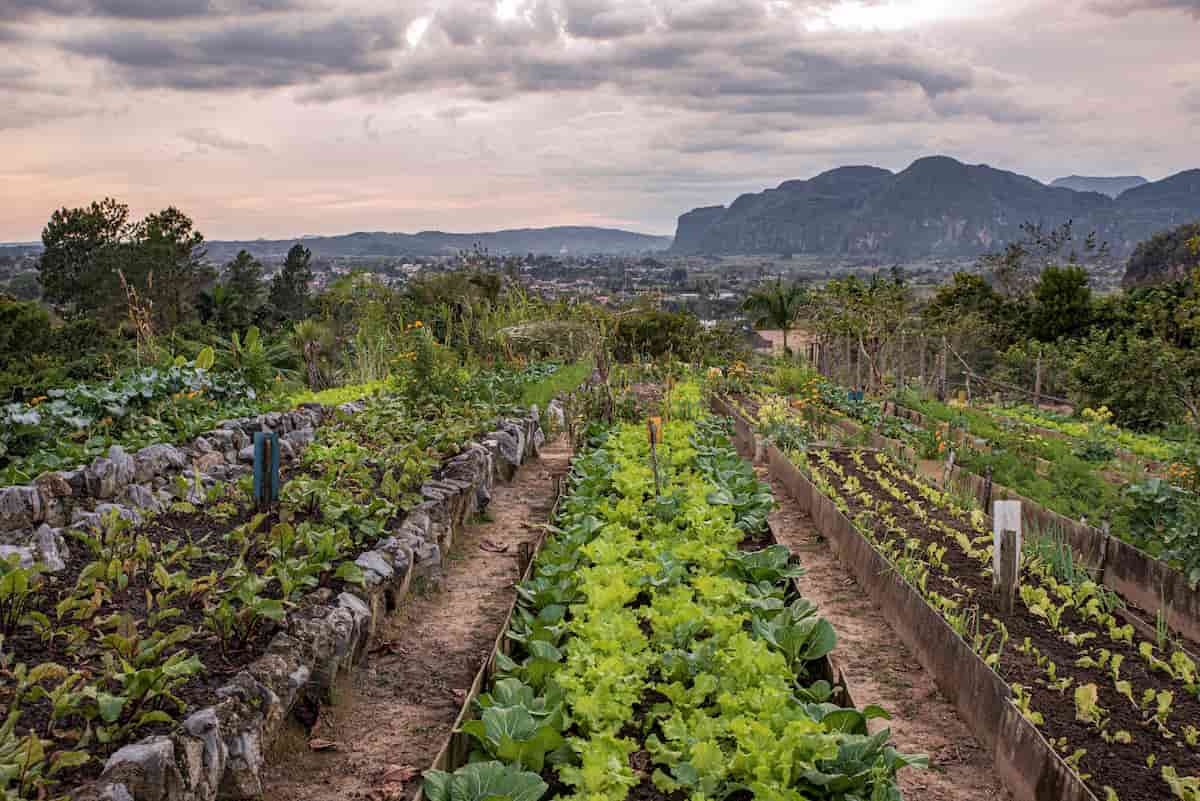Organic farming produces fresh, pesticide-free produce. Avoiding synthetic fertilizers and toxic chemicals can create a sustainable, thriving ecosystem that benefits your garden and the environment. Below we learn the steps to create your own organic garden, whether you’re a seasoned gardener or a complete beginner.

How to Start Your Own Organic Garden
Choose the Right Location
The first step in starting your organic garden is to choose the best location for your plants. Ideally, you’ll want a spot with at least six hours of sunlight daily. Fruits, vegetables, and plants flourish in sunlight. Next, consider the soil in the area. Healthy soil is crucial for successful organic gardening, providing essential plant nutrients. Test your soil for pH levels and nutrient content, and consider amending it with organic matter if necessary. Compost, aged manure, or other organic materials can improve soil structure, aeration, and drainage.
Plan Your Garden Layout
Once you have chosen the perfect location, it’s time to plan your garden layout. Consider your garden’s size and plant choices. Be sure to allow adequate space between plants, as overcrowding can lead to poor air circulation and increased disease risk. Companion planting may also boost plant growth. Companion planting involves growing plants that benefit each other, such as marigolds with tomatoes to deter pests or basil with peppers to improve flavor. Research which plants work well together and incorporate this into your garden layout.
Select the Right Plants
When choosing plants for your organic garden, look for varieties suited to your local climate and conditions. Native plants are less water-intensive and pest-resistant. Additionally, opt for open-pollinated or heirloom varieties, as they are generally more adaptable and easier to grow without synthetic fertilizers and pesticides.
It’s also important to start with healthy plants or seeds. Purchase seeds or seedlings from reputable suppliers specializing in organic products, and avoid those treated with chemicals. Healthy plants are more likely to thrive in your organic garden and will be less susceptible to pests and diseases.
Prepare the Soil
Before planting, prepare your soil by clearing away any weeds or debris, and then work in organic matter, such as compost, aged manure, or well-rotted leaves. This will help improve the soil’s structure, drainage, and fertility. You can also add organic fertilizers, like bone meal or blood meal, to provide additional nutrients. To maintain healthy soil throughout the growing season, regularly add more organic matter and consider using mulch to help retain moisture, suppress weeds, and regulate soil temperature. Mulch options include straw, wood chips, or shredded leaves.
Plant Your Garden
Now that your soil is prepared, it’s time to plant your organic garden. Follow the planting instructions for each variety, ensuring that you space your plants properly and plant at the appropriate depth. Native plants are more pest- and disease-resistant and need less water and care.
Pest and Weed Control
Organic farming requires non-chemical pest and weed control. Fortunately, you can employ many natural methods to help keep your garden healthy and thriving. For weed control, use a mulch to suppress weed growth, or try hand-weeding, hoeing, or using a flame weeder for larger areas. To manage pests, encourage beneficial insects like ladybugs, lacewings, and predatory mites by planting various flowering plants and providing habitats like insect hotels.
You can also use physical barriers like floating row covers or copper tape to protect your plants from pests like cabbage moths or slugs. In addition, practice crop rotation to disrupt the life cycles of pests and diseases. By changing the location of specific plant families in your garden each year, you can help prevent the soil’s buildup of pests and diseases. For example, avoid planting tomatoes in the same spot year after year, as this can lead to soil-borne diseases like tomato blight.
In case you missed it: Organic Gardening Solutions with Worm Castings: Sustainable Idea for Healthy Produce

Fertilizing Your Garden
Organic gardens rely on natural fertilizers to provide essential nutrients for plant growth. Compost is an excellent choice, as it adds organic matter and beneficial microorganisms to your soil. Other options include worm castings, fish emulsion, and seaweed extracts. To determine the appropriate fertilizing schedule for your garden, consider the specific needs of your plants and the nutrient content of your soil. Generally, it’s best to apply organic fertilizers in small amounts throughout the growing season rather than in a single large application.
Pruning and Training Your Plants
Proper pruning and training can help improve air circulation, promote healthy growth, and increase the yield of your organic garden. Prune plants like tomatoes, peppers, and cucumbers to remove dead or diseased foliage and encourage the growth of strong, productive branches. For vining plants, such as peas, beans, and squash, consider using trellises or other supports to help keep the plants off the ground, reducing the risk of pests and diseases. This will also save space in your garden and make harvesting easier.
Harvesting Your Produce
One of the most rewarding aspects of organic gardening is enjoying the fruits (and vegetables) of your labor. Be sure to harvest your produce at the peak of ripeness for the best flavor and nutritional content. Regular harvesting will encourage your plants to continue producing throughout the growing season. When harvesting, use clean, sharp tools to avoid damaging the plants and be gentle to prevent bruising or tearing. Store your harvested produce in a cool, dark place to help maintain freshness and quality.
Preparing for the Next Season
As the growing season ends, take the time to prepare your organic garden for the following year. Remove any dead or diseased plant material, and add it to your compost pile (unless it’s diseased, in which case it should be disposed of properly). Incorporate additional organic matter into the soil, and consider planting a cover crop to help protect and nourish the soil over the winter months.
In case you missed it: Organic Garden Pest Control: DYI Step-By-Step Guide

Conclusion
Starting your own organic garden is a rewarding and sustainable way to grow fresh, healthy produce. Following these steps, you can create a thriving garden that benefits you and the environment. With patience, persistence, and a little knowledge, you’ll enjoy the fruits of your labor in no time.
- Ultimate Guide to Ossabaw Island Hog: Breeding, Raising, Diet, and Care
- Ultimate Guide to Juliana Pig: Raising Facts, Size, Diet, Care, and Lifespan
- Raising Lleyn Sheep: Disadvantages, Price, Uses, Characteristics, and Care
- Ultimate Guide to Meishan Pig: Breed Facts, Breeding, Raising, and Care
- Ultimate Guide to Teacup Pigs: Raising, Diet, Lifespan, Cost, and Care
- Guide to Raising Poll Dorset Sheep: Facts, Profile, Characteristics, Uses, and Care
- Ultimate Guide to Bighorn Sheep: Characteristics, Diet, Lifespan, Breeding, and Lifecycle
- Ultimate Guide to Raising Katahdin Sheep: Farming Facts, Breed Profile, Uses, and Care
- Ultimate Guide to Raising Oreo Cows: Belted Galloways Farming Facts, Profile, Uses, and Care